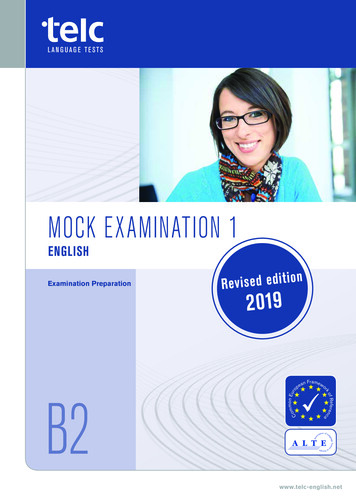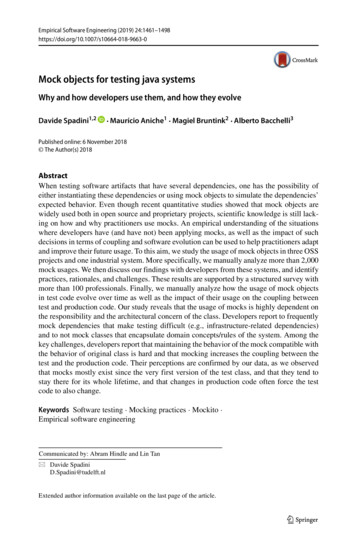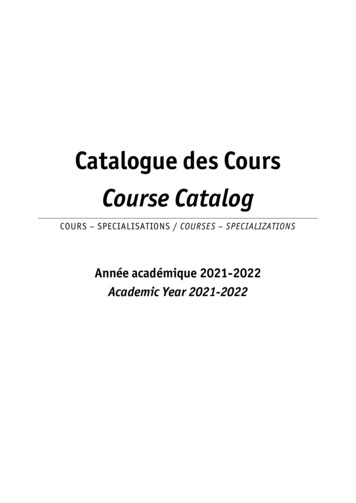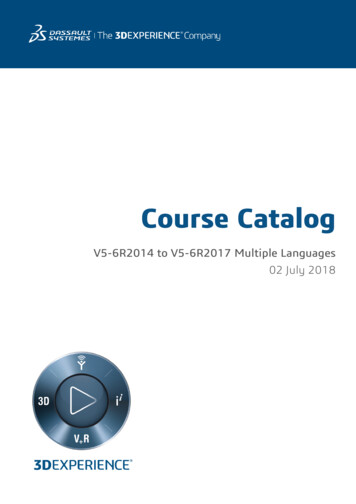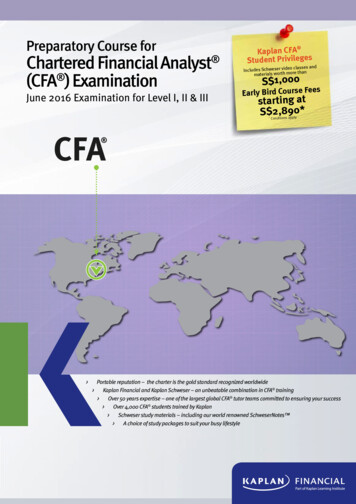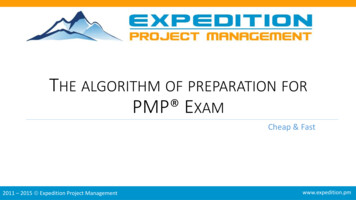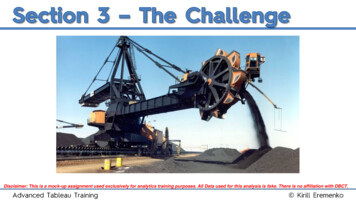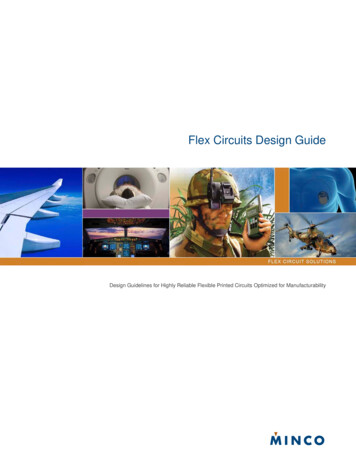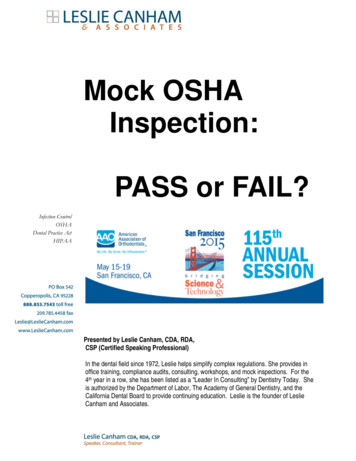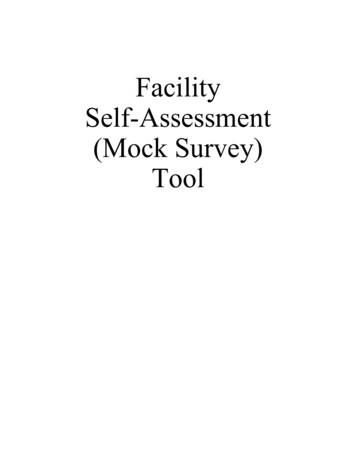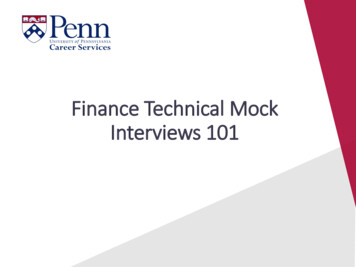
Transcription
Finance Technical MockInterviews 101
Today’s discussion Interview format Technical questions: Accounting Technical questions: Valuation Industry-based questions Other resources2
Most investment banking interviews follow similarformats, and most banks are looking for similar skillsBanking interviews are short and have bothqualitative and quantitative portionsLengthInterviewersQuestiontypes 30 minutes (occasionally 45minutes) Typically 1-on-1 or 2-on-1 Interviews mostly be currentinvestment bankers Qualitative: behavioral, randomquestions Quantitative: technical (accountingand finance)Banks are looking for enthusiasm,communication skills, analytical capacity andcultural fitEnthusiasm /passion Interest in investment banking asrole (and thus willingness to learnand work long hours) Test through technical and bankingknowledgeCommunication Verbal and written communicationstyle (banking is more writing thanskillsmost realize!)Analyticalcapacity Quantitative aptitude (willingnessto learn and comfort withnumbers)Cultural fit Personality and workstyle similarto that of other successful bankers “Airport” test (subject tointerviewer interpretation)3
Investment banking interviews typically consist of similartypes of questionsOpening “Tell me about yourself” “Walk me through your resume” Opportunity to go through your full story, start the interview with thenarrative you wantWhy “Why banking” “Why this bank” “Why this city” “Why this group” Opportunity to show your knowledge of the specific bank or team, andhighlight why your passionate about themBehavioral “Tell me about a time when ” Opportunity to tell stories that paint you in the best light and highlight yourspecific strengths / skillsTechnical “Walk me through the financial statements” “How do you value a company” Opportunity to show your enthusiasm for banking by knowing the basics ofthe quantitative aspects of the jobRandom Set of questions that are hard to predict and vary by interviewer Include strengths / weaknesses, level of commitment, sell yourself, and longterm future questionsClosing “Do you have any questions for me” Questions from you to the interviewer Important to not end on a bad note4
Technical questions: Overview Preparing for technical questions is important toshow knowledge and passion for investmentbanking Even if they like you, a poor performance on thetechnical component will hurt your chances Conceptual understanding is most important Two primary types of questions will be Accountingand Valuation Others include Enterprise/Equity value, Merger Modeland occasionally LBO5
Today’s discussion Interview format Technical questions: Accounting Technical questions: Valuation Industry-based questions Other resources6
Top accounting concepts to know1. The three financial statements and what each onemeans2. How changes in individual items on each of thefinancial statements affect one another and why3. What individual line items on the statements mean(i.e. Goodwill, shareholders equity, etc.)4. Different methods of accounting (cash-based vs.accrual) and when revenue and expenses arerecognized5. When to expense something and when to capitalize it7
What are the three financialstatements? Income Statement Cash Flow Statement Balance Sheet8
Income Statement The Income Statement (IS) showsthe company’s revenue andexpenses, taxes and after-tax profit 1 Shows a company’s performance2over a period of time To appear on the income statement,a line item must: Correspond to the period shown on thestatement3 Affect the company’s taxes i.e. interest paid on debt is tax-deductibleso it appears on the IS but repayingdebt principal is not tax-deductible, so itdoes not appear on the IS.49
Income Statement1.2.3.4.Revenue and Cost of Goods Sold (COGS):Revenue is the value of the products/servicesthat a company sells in the period (Year 1 orYear 2), and COGS represents the expenses thatare linked directly to the sale of thoseproducts/services.Operating Expenses: Items that are not directlylinked to product sales – employee salaries,rent, marketing, research and development, aswell as non-cash expenses like Depreciation andAmortization.Other Income and Expenses: This goesbetween Operating Income and Pre-TaxIncome. Interest shows up here, as well asitems such as Gains and Losses when Assets aresold, Impairment Charges, Write-Downs, andanything else that is not part of the company’score business operations.Taxes and Net Income: Net Income representsthe company’s “bottom line” – how much inafter-tax profits it has earned. Net Income Revenue – Expenses – Taxes.123410
Balance Sheet The Balance Sheet (BS) shows thecompany’s resources – its Assets - andhow it acquired those resources – itsLiabilities & Equity Snapshot of a company at a specificpoint in time Key rules:For both assets andliabilities : Currentis less than a year,long-term is morethan a year Assets must always equal Liabilities Equity An Asset is an item that results inadditional cash in the future. A Liability is an item that will result in lesscash in the future. Liabilities are used tofund a business. Equity line items similar to but they referto the company’s own internaloperations11
Balance SheetLet’s think about a relatable example. Your favoriteAunt Susie owns a home. When thinking about herbalance sheet:AssetsLiabilitiesPersonalinvestments 50,000MortgageCash 30,000EquityHouse 500,000After-tax savingsfrom earningsTotal Assets 580,000 380,000 200,00Total Liabilities 580,000Just like a company’s balance sheet, your personalbalance sheet must always balance.12
Cash Flow Statement The Cash Flow Statement (CFS)tracks changes in a company’scash balance Shows flows over a period oftime Exists for 2 primary reasons Non-cash revenues and expenseson the IS need to be adjusted toshow change in cash balance Show additional cash inflows andoutflows not yet on the IS13
Cash Flow Statement1.2.3.1Cash Flow from Operations (CFO) – NetIncome from the Income Statement flowsin at the top. Then, you adjust for noncash expenses, and take into account howoperational Balance Sheet items such asAccounts Receivable and Accounts2Payable have changed.Cash Flow from Investing (CFI) –Anything related to the company’sinvestments, acquisitions, and PP&Eshows up here. Purchases are negative3because they use up cash, and sales arepositive because they result in more cash.Cash Flow from Financing (CFF) – Itemsrelated to debt, dividends, and issuing orrepurchasing shares show up here.14
Primary questions on the threefinancial statements Walk me through the three financial statements? How do the three financial statements linktogether? If I were stranded on a desert island, only had 1statement and I wanted to review the overall healthof a company – which statement would I use andwhy? Let’s say I could only look at 2 statements to assessa company’s prospects – which 2 would I use andwhy?15
Walk me through the three financialstatements? How do the three financialstatements link together?6412374434233515Don’t forget to flip the signsof certain items!(i.e. Gains and Losses)57 616
Walk me through the three financial statements.The 3 major financial statements are the Income Statement, Balance Sheet andCash Flow Statement.The Income Statement shows the company’s revenue and expenses over aperiod of time, and goes down to Net Income, the final line on the statement.The Balance Sheet shows the company’s Assets – its resources – such as Cash,Inventory and PP&E, as well as its Liabilities – such as Debt and AccountsPayable – and Shareholders’ Equity – at a specific point in time. Assets mustequal Liabilities plus Shareholders’ Equity.The Cash Flow Statement begins with Net Income, adjusts for non-cashexpenses and changes in operating assets and liabilities (working capital), andthen shows how the company has spent cash or received cash from Investingor Financing activities; at the end, you see the company’s net change in cash.
How do the three financial statements link together?1. Net Income from the bottom of the IS becomes the top line of the CFS.2. Add back non-cash expenses from the IS (and flip the signs of items suchas Gains and Losses).3. Reflect changes in operational BS line items – if an Asset goes up, cashflow goes down and vice versa; if a Liability goes up, cash flow goes upand vice versa.4. Reflect Purchases and Sales of Investments and PP&E in Cash Flow fromInvesting.5. Reflect Dividends, Debt issued or repurchased, and Shares issued orrepurchased in Cash Flow from Financing.6. Calculate the net change in cash at the bottom of the CFS, and then linkthis into cash at the top of the next period’s BS.7. Update the BS to reflect changes in Cash, Debt, Equity, Investments, PP&E,and anything else that came from the CFS.
Watch out for these common pitfalls: BS doesn’t balance – it must always balance Duplicating effects of BS changes on the CFS Reflect each Balance Sheet item once and only once on the Cash Flow Statement, and vice versa. Affect an increase/decrease in assets or liabilities have on the BS If an Asset goes up, cash flow goes down; if a Liability goes up, cash flow goes up, and vice versa. Forgetting to flip signs on the CFS Common example is Gains or Losses on Asset Sale: Must list in both cash flow from operations and cashflow from investing because you are re-classifying the cash flow. You subtract it from CFO and insteadinclude it as part of the full selling price of the assets in CFI instead. Accounts payable vs. Accrued expenses Mechanically, they are the same: Liabilities on the BS used when you’ve recorded an IS expense for aproduct/service you have received, but have not yet paid for in cash. The difference is that AccountsPayable is mostly for one-time expenses with invoices, such as paying for a law firm, whereas AccruedExpenses is for recurring expenses without invoices, such as employee wages, rent, and utilities Accounts receivable vs. Deferred revenue Primary differences: (1) Accounts Receivable has not yet been collected in cash from customers,whereas Deferred Revenue has been (2) Accounts Receivable is for a product/service the company hasalready delivered but hasn’t been paid for yet, whereas Deferred Revenue is for a product/service thecompany has not yet deliveredAccounts Receivable is an Asset because it implies additional future cash whereas Deferred Revenue is aLiability because it implies the opposite.19
If I were stranded on a desert island only had 1statement to review the overall health of acompany – which statement would I use and why?The Cash Flow Statement! It gives a true picture of how much cash the company isactually generating. This is ultimately the #1 thing you careabout when analyzing the financial health of any business –its true cash flow Income Statement is misleading because it includes noncash expenses and excludes actual cash expenses such asCapital Expenditures20
If I had only two statements to use which would Iuse and whyIncome Statement and Balance Sheet! You can create a rough cash flow statement from both ofthose (assuming you have “Beginning” and “Ending” BSsthat correspond to the same period the IS is tracking)21
Changes on the three financialstatements Single Step: Walk me through how depreciation going up by 10would affect the three statements? Multi-step: A company makes a 100 cash purchase of equipmenton Dec. 31. How does this impact the three statementsthis year and next year?Helpful Tip - Use the following order when walking throw thesetypes of questions:1. Income Statement 2. Cash Flow Statement 3. Balance Sheet22
Walk me through how depreciation going up by 10 would affect the three statements? Note: Before starting, always confirm what tax rate to use, givenrecent changes to corporate tax – fair to assume 20% IS: Operating income and pre-tax income would decline by 10,tax shield of 2, net income is down - 8 CFS: Net income at top goes down by 8, but 10 depreciation isa non-cash expense so gets added back. Overall cash flow fromoperations (CFO) goes up by 2. No other changes – net change incash is 2 BS: PPE decreases by 10 on asset side (depreciation), cash is 2from changes in CFS, so Assets down by 8. Net income wasdown - 8, so is shareholders equity on Liabilities and Equity side. Balance sheet is now balanced!23
Walk me through how depreciation going up by 10 would affect the three statements? Intuition: We save taxes on all non-cash chargessuch as depreciation Further testing: ask yourself the same questionwith different numbers, decreasing depreciation orwith changes in different line items, i.e. accruedexpenses, accounts receivable, inventory, etc. Feeling confident? Try out the next multi-stepexample to see how comfortable you are withaccounting!24
Multi-Step Scenario1. Apple is buying 100 worth of new iPad factorieswith debt. How are all 3 statements affected at thestart of Year 1?2. In Year 2, Debt is high-yield, so no principal is paid off,and assume an interest rate of 10%. Also assume thefactories Depreciate at a rate of 10% per year. Whathappens now?3. At end of Year 2, the factories break down and theirvalue is written down to 0. The loan must also bepaid back now. Walk me through how the 3statements ONLY from the start of Year 2 to the endof Year 2.25
1. Apple is buying 100 worth of new iPad factorieswith debt. How are all 3 statements affected atthe start of Year 1? IS: At the start of Year 1, no effect. CFS: 100 spend on capital expenditures, would decrease CFI - 100; 100 cash inflow from debt financing would increase CFF 100; Nochange in cash. BS: On asset side, PPE has increased 100 from factory purchases; Onliabilities side, debt has increased 100 BS balances!26
2. In Year 2, Debt is high-yield, so no principal is paidoff, and has 10% interest rate. Also assume thefactories depreciate at a rate of 10% per year. Whathappens now? At the start of Year 2, Apple must pay interest expense and recorddepreciation. IS: Operating income decreases 10 (10% depreciation on 100factories) and the additional 10 in interest expense, decreases pre-taxincome by 20. Assuming 20% tax, net income falls by - 16. CFS: Net income at top is down - 16, add back 10 depreciation in CFO(non-cash expense); no further changes, so net change in cash is - 6 BS: On asset side, Cash is - 6, PPE is - 10 (depreciation), bringing totalassets - 16. On liabilities, shareholder’s equity - 16 (linked to netincome changes) BS balances! Note: Debt number doesn’t change since we assume none of theprincipal has been paid back.27
3. At end of Year 2, the factories break down andtheir value is written down to 0. The loan must alsobe paid back now. Walk me through how the 3statements ONLY from the start of Year 2 to the end ofYear 2. After 2 years, given 10% annual depreciation, the factories are valued at 80. This is the value we need to write down. IS: Operating income decreases 90 (10% depreciation on 100factories 80 write-down), and the additional 10 in interest expense.Thereby decreasing pre-tax income by 100. Assuming 20% tax, netincome falls by - 80. CFS: Net income at top is down - 80; in CFO, add back 90 depreciation write-down in CFO (non-cash expense); in CFF, - 100 due to payingback the loan principle; so net change in cash is - 90 BS: On asset side, Cash is - 90, PPE is - 90 (depreciation write-down),bringing total assets - 180. On liabilities, debt is - 100 (paid-off),shareholder’s equity is - 80, thereby total liabilities - 180.28
Common Pitfalls Recognizing a change in inventory on the IS Not understanding the difference between certainline items Forgetting effect of tax When phrasing changes, i.e. “A company sells somePP&E for 120 but it’s worth 100 on its BS. Walkme through.” When in doubt, always ask a question to clarify!29
Today’s discussion Interview format Technical questions: Accounting Technical questions: Valuation Industry-based questions Other resources30
Top Valuation questions How can you value a company? What are the threemain valuation methodologies? Which methodology gives the highest value? How do you present these to a client? What is a DCF? How do you calculate free cash flow (FCF)? Walk me throughhow you get from Revenue to FCF? How do you calculate WACC? How do you calculate cost of equity? What is beta? How do you calculate Terminal Value (TV)? How would you value this [random object]?31
How can you value a company? What arethe three main valuation methodologies?There are three primary ways to value a company:1.2.3.4.5.6.Comparable companies analysisPrecendent transaction analysisDiscounted Cash Flow (DCF)Leveraged Buyout (LBO)Sum-of-the-partsMerger consequences analysisRelative ValuationIntrinsic ValuationBe able to discuss benefitsand disadvantages of eachmethod!A relative valuation uses financials from other public companies and recent M&Adeals to estimate what the company you are valuing may be worth.For an intrinsic valuation you can: (1) Estimate future cash flows and discount themback to their present value (money today is worth more than money tomorrow), or(2) Value the firm’s assets and assume the firm’s total value is linked to its adjustedasset value minus its liabilities32
Topics you must understand about a DCFanalysis1. What it is and be able to walk through it2. How to calculate and project Free Cash Flow(FCF)3. How to calculate the discount rate, and applyWACC and cost of equity4. How to calculate the Terminal Value, what it isand how it affects a DCF33
What is a DCF?In a DCF analysis, you value a company with the Present Value of itsFree Cash Flows (FCF) plus the Present Value of its Terminal Value:1.Project a company’s FCF over a 5-10 year period2.Calculate the company’s Discount Rate, usually using WACC(Weighted Average Cost of Capital).3.Discount and sum up the company’s Free Cash Flows.4.Calculate the company’s Terminal Value using either theMultiples Method or Gordon’s Growth (Perpetuity) Method5.Discount the Terminal Value to its Present Value.6.Add the discounted Free Cash Flows to the discounted TerminalValueSee where these steps happen on an actual DCF on the next page!34
Lemonade Stand DCF-132(-/ )-RevenuesCost of Goods SoldGross ProfitOperating ExpensesOperating Income (EBIT)Tax ExpenseAfter-tax ProfitDepr., Amort., and other non-cash chargesChanges in Operating Assets and LiabilitiesCapital ExpendituresUnlevered Free Cash FlowPresent Value (FCF/(1 Discount Rate Year)DCF ValuationAssumptionsExpected revenue growthEffective tax rateDiscount rate (WACC)Terminal Growth rate10%10%10%2%61 10,800( 2,700) 8,100( 5,190) 2,910( 291) 2,619( 10)( 20)( 40) 2,549 2,317 63,3732 11,880( 2,970) 8,910( 5,709) 3,201( 320) 2,881( 10)( 20)( 40) 2,811 2,783Operating ExpensesUber ( 6/day)Payroll ( 50/day)Park license ( 150/summer)Total3 13,068( 3,267) 9,801( 6,280) 3,521( 352) 3,169( 10)( 20)( 40) 3,099 3,0964 14,375( 3,594) 10,781( 6,908) 3,873( 387) 3,486( 10)( 20)( 40) 3,416 3,4165 15,812( 3,953) 11,859( 7,599) 4,261( 426) 3,834( 10)( 20)( 40) 3,764 3,764TerminalValue4 47,997 540 4,500 150 5,190355
Why do you calculate a company’s FCF?How?A company’s FCF closely corresponds to the actual cash flow that the investorwould receive each year if s/he bought the entire company. To calculate this:1.Project a company’s revenue growth (% expected to grow over projectedperiod)2.Assume operating margin to calculate EBIT or operating income3.Apply effective tax rate to calculate net operating profit after tax (NOPAT)4.Use CFS to project 3 key items that impact FCF: non-cash charges(depreciation and amortization), changes in operating assets and liabilities(net working capital), and capital expenditures Add back non-cash charges Subtract if Assets increase more than liabilities Subtract capital expenditures5.Now you have your Unlevered FCF!36
Now what?.Right, discount the FCFs tothe present value. How?1. What discount rate would you use? Weighted Average Cost of Capital (WACC)2. What is WACC? Calculates the company’s cost of debt and equity, weightedbased on it’s capital structure WACC cost of debt *(% debt)*(1 – tax rate) cost ofequity*(% equity) Cost of Preferred * (% Preferred)3. What is the cost of debt? It’s interest rate on it’s debt4. What is the cost of equity? Cost of equity risk-free rate market (equity) riskpremium*beta37
What next?.Terminal value .How doyou calculate that?Two different methods: Multiples method and GordonGrowth Method1. Multiples: Often used and based on public comps.EBITDA multiple of ?x – would often provide a range2. Gordon Growth or Perpetual Growth – assumes thecompany operates indefinitely and sums future cashflows TV Final year FCF *(1 Terminal FCF Growth Rate) /(Discount Rate – Terminal FCF Growth Rate). What would you use for Terminal growth rate? It should bevery low – less or equal to country’s GDP growth rate or rateof inflation38
Then Add PV of TV to PV of FCF in the projected period toget your final valuation!Potential follow-ups questions: Which components of a DCF tend to have thegreatest impact on the valuation? Discount rate and terminal value39
Additional rules to remember / to test onregarding DCF componentsEffect on Cost of EquitySmaller companies and companies in fast growing industries orcountries have higher expected returnsAdditional debt because it increases riskAdditional equity because it decreases percentage of debtEffect on WACCSmaller companies and companies in fast growing industries orcountries have higher expected returnsHigher interest rate because it increases cost of debtAdditional debt because debt is less expensive than equity40
Today’s discussion Interview format Technical questions: Accounting Technical questions: Valuation Industry-based questions Other resources41
Industry-based questions Explain the sub-prime mortgage crisis. What happened? Let’s say you had 10 million to invest in anything. What would you dowith it? First ask what are the investor’s goals – base response on investment horizon If you owned a small business and were approached by a largercompany about an acquisition, how would you think about the offer,and how would you make a decision on what to do? would you do with it? Key terms to consider are: price, form of payment (cash, stock, debt), futureplans for company What trend or company in the industry have you been following? Do research or specific industry beforehand Describe something irrelevant, don’t explain the “why” or impact on the market Talk about a company you admire. Why? Focus on qualities investors would find appealing Don’t choose brand name, i.e. Apple, Google, Amazon, etc.42
Today’s discussion Interview format Technical questions: Accounting Technical questions: Valuation Industry-based questions Other resources43
Additional Resources Blog with recruiting advice for breaking into investment bankingMergers andInquisitions Several articles on networking (how to approach informationsessions, what to ask during informational interviews, etc.) Additional resources for interview prep and non-IBD recruitingas well Forum with dedicated rooms for banking, sales and trading, etc.Wall Street OasisCareer ServicesMany more! Significant amount of quality content and advice – but have toweed through equally significant amount of bad content andadvice; be careful! Career advising appointments can be used to discussnetworking approach and strategy Mock interviews with career services staff for in-personfeedback Countless articles, books and websites dedicated to advice onnetworking and interviewing Networking can be used in more contexts than justundergraduate recruiting – many of these resources can help!44
Snapshot of a company at a specific point in time Key rules: Assets . must always . equal Liabilities Equity An Asset is an item that results in additional cash in the future. A Liability is an item that will result in less cash in the future. Liabilities are used to fund a business. Equity line items similar to but .
